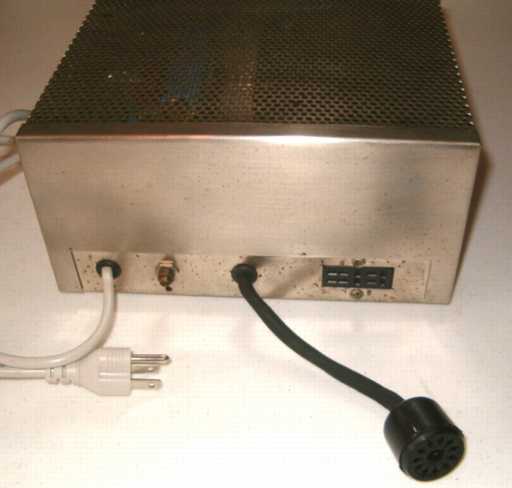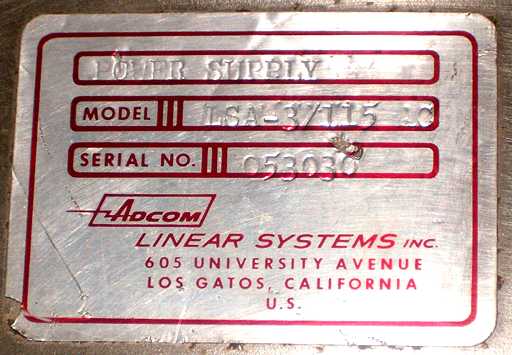
Adcom LSA-3 /115VAC power supply with HP-23 compatible 11 pin socket pigtail installed.

Adcom Linear Systems LSA-3/ 115 AC power supply
This piece was acquired as part of a batch of good "junque" at an auction. I put it aside assuming it was another typical low-voltage supply. Upon opening it, I was surprised to find a high-voltage power supply for a tube-type transceiver with similar capability to the Heathkit HP-23 series. The transformer is beefier than that of the Heathkit. I had no documentation on the power supply but drew the schematic.
The voltages in this and other power supplies designed for vacuum tube receivers and especially transmitters are lethal. If you are not very experienced at working on such equipment, seek competent local help.
For its highest voltage, this power supply uses four 100 MFD 450 volt electrolytics in series/ parallel giving the equivalent of two 200 MF caps in series. It has two 100K ohm resistors to match the voltage drop between the series cap pairs. Two of the four electrolytics were bad and were replaced. The other two reformed very well. On testing with a variac at relatively low voltage, I found that the equalizing resistors were not well matched and had allowed one pair of the caps to see a higher proportion of voltage than the other pair. I replaced those resistors and decided to add another pair of 100K resistors in parallel as Heath had done in its supplies. The four resistors result in 50K ohms across each capacitor pair. After resistor replacement, testing showed the voltage drops across the capacitor pairs to be equal.


Caution! More than 900 volts.
While still doing low voltage Variac tests, I estimated the DC output voltage if full AC were to be applied and determined that the caps would see over 900 volts at no load if any more than about 117 volts AC was applied. That is over their rating. My line voltage is nominally 120 but hovers around 124 or so at times.
With only a limited load, this power supply not be operated at more than 115 VAC input, as shown on the nomenclature label to avoid stressing the caps. Use a variac or other means to limit input voltage. After repairs, I confirmed that the 900 volts can easily be exceeded. Even at 900 volts, the capacitors may be stressed if the resistor divider is not perfect.
The high voltage is fed by a bridge rectifier arrangement as compared to the Heath's half-wave doubler arrangement. A review of similar ARRL Handbook circuits show the use of three stacked 450 electrolytics rather than two if the output voltage approaches the 900 volt range. A change to three stacked caps would seem appropriate.
Plug compatibility with the Heath HP-23
I was not able to locate a matching Jones plug. Since I wanted a Heathkit HP-23 plug-compatible supply, I decided to add a well-insulated 11 pin socket pigtail that I had "liberated" from an old Motorola commercial VHF set. The hole in the power supply chassis through which I ran the pigtail had been occupied by the fuse assembly. I replaced the fuse assembly with a chassis-mount fuse holder inside the case. The 11 pin socket connections were matched to the Heath HP-23 configuration. Other than the very highest transmitter voltage, the other voltages for receiver, for bias, and for filament were within the ballpark of those of the HP-23.
Information needed.
If you find an advertisement or other documentation for this piece, please let me know. Since the transformer is beefier than that of the Heath, I would like to know the rating and specifications for output current for each of its voltages. For what transceiver was it typically used? I suspect that the idling current of the transmitter final output tube or tubes may have been part of the formula in keeping the design maximum voltage down somewhat below 900 volts.
I am giving thought to changing the transmitter high voltage to choke input to reduce the stress on the caps.
Follow up. Installed a choke.
I found a choke of proper size and current rating and installed it on top of the chassis. Existing holes were used for mounting the choke. Full load voltage is expected to be about 670 volts at normal line input. Textbook information says that the choke input circuit should give excellent regulation and filtering. The electrolytics are no longer stressed beyond their working voltage, and I will not need to reduce the input voltage. The mod is easily reversible and makes this supply more compatible with the popular Heath HP-23 which is rated at 700 volts at a load of 250 Ma.
Update on the LSA-3/ 115 VAC
Thanks to W9JWB who alerted me to information on ebay. An Adcom Linear Systems model LSA-3 is actually a linear RF amplifier using four 7984 RF output tubes in parallel. The LSA-3/ 115 VAC is the 115 volt AC power supply for that rig. The power requirements for that RF amp are noted as 650 mA at 800 volts, 100 mA at 270 volts, and a negative bias of 90 volts. I am assuming those are ICAS (intermittent commercial and amateur service) service or possibly the less demanding IMS (intermittent mobile service) rating. Such high voltage and current provide a plate input power of about 500 watts, serious power indeed. The LSA-3 power supply should have no trouble handling any application calling for an HP-23, and that at CCS (continuous commercial service).
Powering four 7984 tubes
I questioned the validity of the 650 mA of highest voltage output for this supply. For a reality check, I looked up the plate voltage and screen voltages and current requirements of a 7984 in ICAS operation. At the tube's "Absolute Maximum Values" of 750 volts on the plate and 250 volts on the screen, the plate current is 150 mA per tube in ICAS. Therefore the 650 mA at 800 is believable with 270 on the screen grids (and exceeding the maximum ratings of the tubes).
I also have an Adcom 12 volt power supply that matches the LSA-3 RF amp. It is labeled "350-12" "DC-to-DC converter" and requires a 30 amp fuse. Obviously, that limits that power supply to a combined maximum of all outputs to about 350 watts which coincides with the 350 in the model number. I have not tested that supply but am assuming lower output voltages.
The Adcom LSA-3 RF amp has switch settings for operation on the 20, 40, and 80 meter ham bands. However, I have not yet seen it in ads in older ham magazines. Therefore, I am wondering if it may have been sold as a "leenyar". If you have more information, let me know.
Experimenting with a Home Brew Regenerative Receiver was the previous item on the bench.